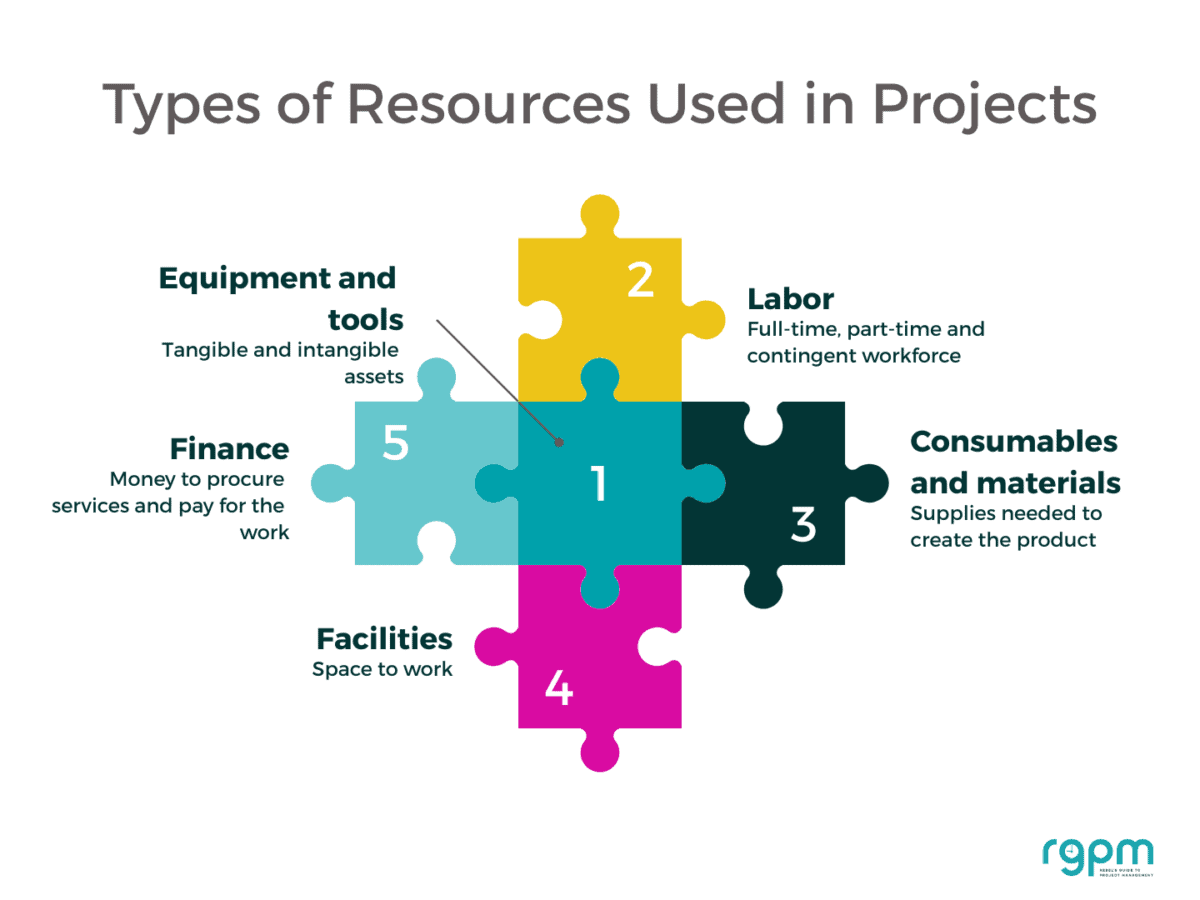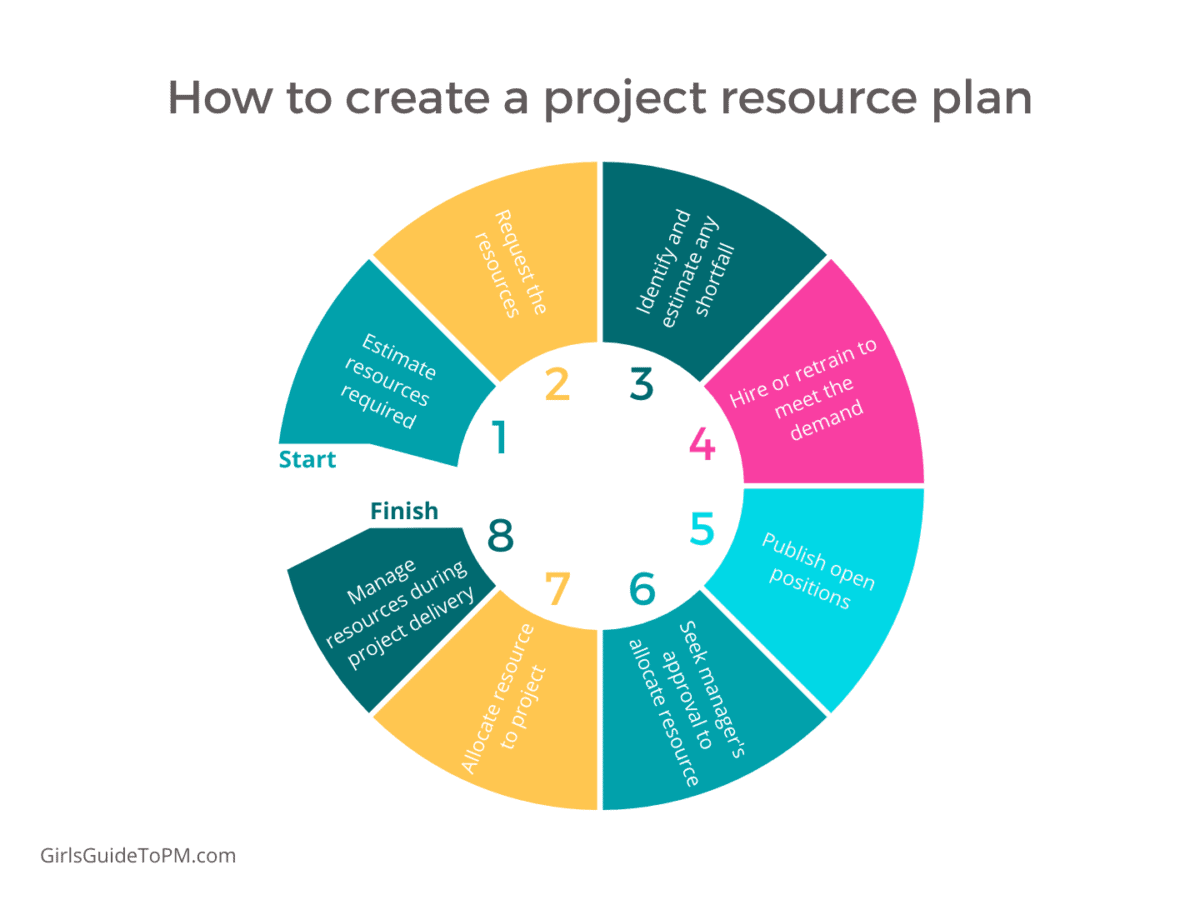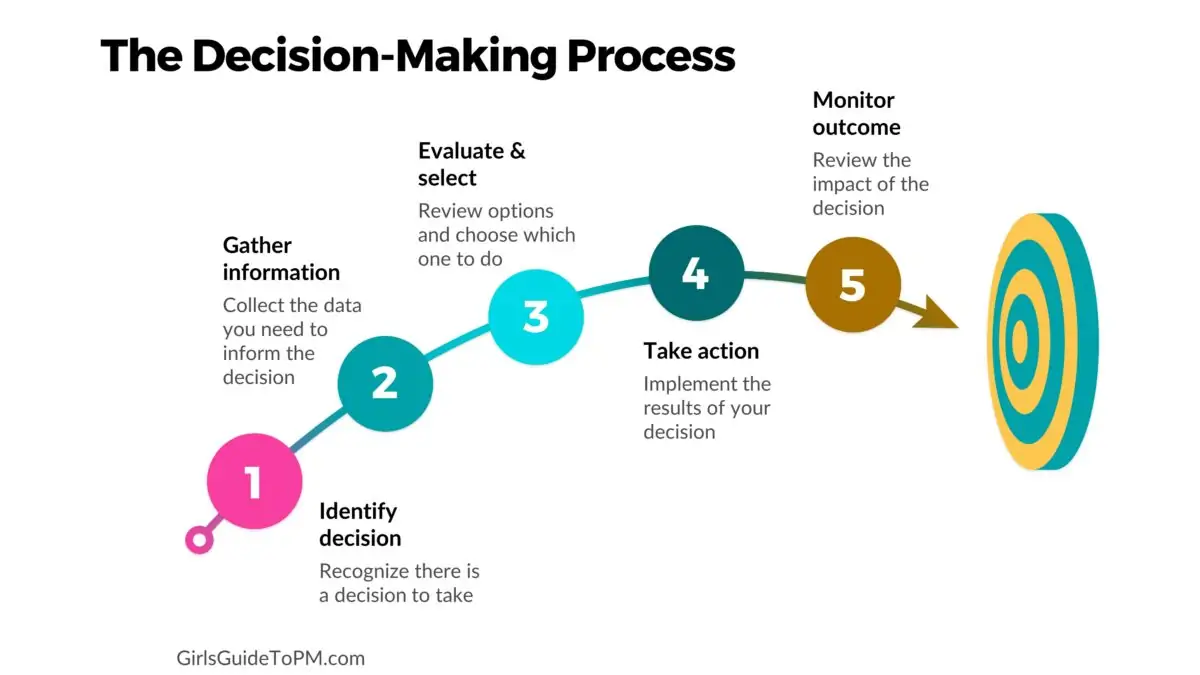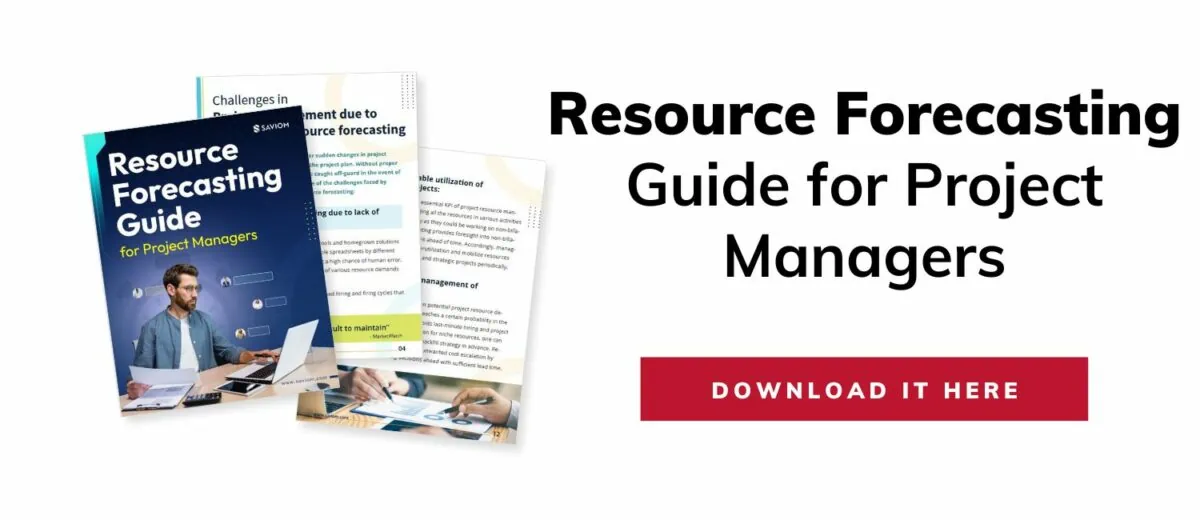Resource Forecasting Guide for Project Managers
Managing resources in professional services firms is crucial for maintaining sustainability and achieving anticipated employee performance goals. But unfortunately, many resource managers have to rely on approximation and guesswork because they don’t have the right tools and techniques.
In the dynamic business environment, companies need accurate estimations for timely decision-making and futureproofing workforce availability against market volatilities.
Resource forecasting helps managers answer questions like:
- Do I have sufficient capacity and skill sets to take on additional projects?
- What should I do with the excess capacity without sufficient work to engage them?
- How can I stay within the budget with the available resource mix?
A robust resource forecasting model can answer these queries and help businesses stay ahead of the curve. In addition, it provides actionable insights for improving profitability by maximizing billable resource utilization.
In this guide, we will learn the critical aspects of resource forecasting in project management. Let us begin with the basics.
What is resource forecasting in project management?
Resource forecasting predicts various project resource metrics over a specific period, such as demand, supply, project vacancy, on-the-bench, and project resourcing costs in advance.
Resource forecasting is essential in project management to predict the future resource requirements in an organization to complete projects successfully. It is a step-by-step process that project managers can implement to estimate and allocate resources effectively.
It provides early warnings, which help businesses to be proactive and implement preventive measures to avoid resource-related roadblocks in the project.

What is an example of resource forecasting?
Let’s consider an example of resource forecasting in project management.
Suppose a project manager has an upcoming project for website development and design. The project has a defined timeline of six months, and the resources involved are developers, testers, UI/UX designers, analysts, etc. The company wants to accurately forecast and allocate resources to ensure smooth project execution.
The first step is to clearly define the project requirements. This includes understanding the scope, objectives, deliverables, and timeline of the project. Next, the project manager and the team members identify all the tasks and activities required to complete the project.
Based on the identified tasks and activities, the team assesses the resource requirements for each phase of the project.
Using appropriate forecasting tools, managers determine the number of resources required in each phase, identify peak resource demands, and predict any resource shortages or excesses.
By following these steps, the company can effectively forecast and secure the resources for its mobile application project. This ensures that they have the right resources in the right place at the right time, leading to improved project outcomes and successful delivery.
Let’s move on to understand the significance of resource forecasting on the smooth progress of projects.
Why is resource forecasting important in project management?
Before projects kick off, a robust forecasting process ensures they are suitably staffed and equipped to respond to unforeseen circumstances during the entire lifecycle.
It also estimates the workload, skill requirements, and project financials, enabling organizations to achieve profitable resource utilization.
Enterprises fail to deliver projects on time and within budget without the right forecasting tools.
It also results in low client satisfaction and jeopardizes the firm’s reputation.
This is how resource forecasting is essential for project managers.
What are the advantages of resource forecasting?
The significance of efficient resource forecasting in project management is profound. It facilitates effective resource allocation and leads to the success of projects. Additionally, these are some of the critical benefits of resource forecasting in project management, which we’ll discuss below.
Reduces project cost significantly across the organization
Resource costs are the most significant part of the expense for most businesses. The best way to keep this under control is by making sure that the right resources are available at the right time with the help of timely forecasting.
Even though employees are assigned to the project, it does not necessarily translate into more revenue for the business. They could be under-skilled or overqualified, affecting delivery or overall project cost. With their advanced capabilities, modern resource forecasting tools can help businesses significantly improve their profitability.
Deloitte Global Cost Survey reveals, “Cost reduction is the most significant initiative for any business.”
Maximizes resource utilization for billable and strategic work
Resource utilization is one of the most crucial KPIs of resource management. However, engaging all the resources in various activities doesn’t ensure profitability, as they could be working on non-billable or mundane BAU tasks.
Forecasting enables you to gain foresight into non-billable, billable, and strategic work ahead of time. Resource managers can improve profitability by periodically mobilizing resources from non-billable to billable and strategic projects. It helps eliminate under and overutilization of resources.
Enables effective management of pipeline projects
Lack of visibility into the sales pipeline results in the eleventh-hour scuffling for competent resources. Resource forecasting helps plan for the potential project demands in the opportunity or approval sales pipeline.
Forecasting helps in resource capacity planning to avoid last-minute hiring and project delays. If there is an open position for niche resources, implement an out rotation and backfill strategy in advance. Resource forecasting also reduces unwanted cost escalation by making the right hiring decisions ahead with sufficient lead time.
Controls excesses/shortages of resources
An efficient resource forecasting tool enables you to perform multidimensional capacity vs. demand analysis based on role, department, team, location, skills, etc. It helps identify short and long-term resource excesses or shortages and proactively bridge the capacity gap.
Resource shortages can be controlled by providing training and hiring a permanent or contingent workforce. On the other hand, bringing forward project timelines or selling excess capacity mitigates the problem of excesses. Resource forecasting also minimizes bench time by providing training or shadowing opportunities.
Eradicates project planning bottlenecks
To organize the teamwork into manageable sections, the project manager divides the project into component tasks and creates their dependencies. It is known as the work breakdown structure and is designed to meet the project objectives and create the deliverables.
Due to their dependencies, delays caused by a critical resource’s unavailability in completing their work can delay other tasks and meet milestone deliverables. Subsequently, the project fails to deliver on time and within budget.
Resource forecasting makes the right resource available at the appropriate time.
Manages project financials to stay ahead of the curve
Periodically monitoring critical financial indicators such as cost, overheads, revenue, and profit margins ensures the project budget is on track. In addition, you can control project resource costs in advance by comparing the actual spending against the estimated budget.
Forecasting project financials helps you to improve future estimations and align them to reality. It also tracks shared resources working on multiple projects to adjust the resource mix for increasing revenue.
Plans proactive hiring and reduces benched resources
Forecasting project resources provide visibility for a workforce ending on the bench after a specific date. Additionally, it helps minimize bench time by proactively looking for appropriate tasks before resources are rolled off from projects.
Forecasting project vacancies across the enterprise enable the allocation of appropriate benched resources. Forecasting resources required also improves billability by facilitating training or shadowing opportunities for benched resources to assign them to projects quickly. You can also proactively make hiring decisions to address any resource shortfalls.
Now that the benefits of resource forecasting are clear, let’s look at the challenges in predicting resource needs.
Challenges in resource forecasting
Market volatility and sudden changes in project demand can cause an imbalance in the project plan. Without proper resource forecasting tools, firms are caught off-guard in the event of sudden surprises.
Let’s look at some of the problems faced by many organizations in project resource forecasting.
Incorrect forecasting due to lack of appropriate tools
Many organizations are still using legacy tools and home-grown solutions for resource forecasting. In addition, using multiple spreadsheets by different individuals requires reconciliation, causing a high chance of human error.
Silos of spreadsheets fail to provide complete visibility of various resource demands for the project and non-project activities. It cannot forecast workload estimates forcing you to resort to unplanned hiring and firing cycles that adversely impact the bottom line.
Marketwatch states, “88% of spreadsheets are difficult to maintain.”
Unable to forecast enterprise-wide demand vs. capacity
Using legacy tools in resource forecasting prohibits the visibility of existing resource capacity across the enterprise. Lack of foresight into future project needs also breaks the resource demand planning process.
Subsequently, resource managers cannot forecast resource excesses or shortfalls and apply appropriate treatments to bridge the gap.
The inability to predict project vacancies and the resources landing on the bench leads to the wastage of excess capacity. This results in costly hiring/ firing cycles that impact the bottom line.
Inadequate foresight into billable and strategic utilization
To maintain profitability, businesses must ensure that resources are utilized on billable or strategic work. However, resource managers fail to predict team members’ utilization across the enterprise without a proper resource forecasting tool.
Consequently, resource managers cannot mobilize resources from non-billable to billable and strategic work. Lack of foresight may cause under or overutilization of resources resulting in burnout, unplanned attrition, and compromised quality.
Not able to predict and forward plan pipeline project
Two critical parameters mark a project’s success; timely delivery and being within budget. But without clear foresight into pipeline project demands, resource managers cannot plan fulfillment activities ahead of time. It puts projects at risk with delivery delays and cost escalations.
When managers cannot foresee future project resourcing needs, it leads to last-minute hiring activities compromising resource quality. If there is a demand for niche skills to start a project, hiring the same at the eleventh hour becomes challenging without the visibility of pipeline projects.
Estimation for project financial going off-target
Controlling the project budget is essential for its successful delivery. Periodically tracking critical project financial indicators helps you achieve that. However, without a proper resource forecasting system, controlling project costs ahead of time becomes daunting.
Comparing the actual spending with estimated costs helps improve future forecasting. In addition, resource managers can take remedial actions to enhance profitable utilization and avoid billing loss if there is a mismatch.
Having listed the significant challenges, let’s learn the factors impacting resource forecasting in project management.

Factors that affect resource forecasting in project management
Resource forecasting is an important activity for good project management practice. It depends on several factors, including market dynamics. We’ve picked out a few to review in detail.
Complexity of matrix structure
Resource forecasting is done at an organizational level, not for individual projects. The workforce movement between different business units within a matrix structure allows the re-deployment of rolled-off resources.
Resource forecasting will suggest acquiring a new workforce if the business wants to expand in a different geography. At the same time, if the outlook is slow due to poor economic conditions, the hiring activities have to stop.
Look at cross-training existing resources for the current demands if there is a skill mismatch.
Resourcing strategy and market condition
Generally, you would use contingent resources for short-term assignments and choose for full-time employees for critical positions or longer-duration projects. But such a resourcing strategy has its own set of challenges.
The contingent resources’ quality cannot be guaranteed, and permanent employees leave the organization for better prospects. Resources with hot skills are more vulnerable to leaving the organization. The attrition rate could also be high in specific locations, which needs to be analyzed and factored in while forecasting demand for resources.
Keeping up with emerging technologies
You need to forecast both future and current resource demands for sustainability. Of late, there has been an explosion of new IT skills in demand such as IoT, machine learning and AI, Blockchain, Big Data and data science, and more.
Many many existing technologies will be obsolete, and the current workforce needs to pick up new skills to stay relevant.
Therefore, you would want to analyze future projects’ skill requirements as a part of the forecasting process and plan accordingly.
Future client requirements
Estimate future client demands based on the sales pipeline. Resource capacity planning determines the gaps between demand and supply. Forecasting based on this gap will show if there is an excess or shortage of capacity.
Additionally, it will lead to acquiring additional resources or diverting the available workforce to other projects within the organization. A new capability in specific skill areas must also be built for business sustainability.
Sudden ramp-up / ramp-down of resources
Frequent ramp-up and ramp-down of resources within a project can upset the resource planning process. Sometimes the new resource request can come with a short lead time. Usually, the contingent workforce is used to fulfill these kinds of requirements.
However, the PMO needs to forecast this in advance so that you do not compromise on the quality of resources. Building relationships with a few vendor organizations that can supply quality resources within short notice becomes essential.
PwC Project Management Insights states, “30% of project failures are due to resources-related challenges.”
Estimating project financials
Usually, there is a variance between the actual cost and the initial estimated budget. project managers allow additional buffers while committing to the project end date and its approximate cost.
Excess buffers will make the proposal uncompetitive, while the project risk increases with less buffer. So, deciding on an appropriate buffer size is essential in forecasting financials. It also influences the resource requirements for future projects.
Resource movement across locations
Some key resources are often required to work at the client’s site for an extended period to complete a successful project. In addition, the movement of resources between locations can be affected due to administrative delays resulting in client dissatisfaction.
Hiring additional resources at the client’s location becomes necessary in that situation. It will ensure no disruption in project delivery and must be factored into the resource planning and forecasting process.
Tips for resource forecasting in project management
You’ve been asked to sort out resource forecasting, or are proactively looking at it yourself. Here are some tips to make that process easier.
Know the strengths and weaknesses of resources within your project
Resource managers must evaluate the strengths and weaknesses of each team member before assigning them tasks.
Review their past performance based on output quality, skill level, and ability to deliver on time. If a resource lacks the proficiency to execute a project task, consider whether it’s appropriate to upskill them or recruit, for example by backfilling another role.
Understand the skill requirements for your project to complete delivery
Project managers must thoroughly understand the skill sets required to deliver the project within time and budget. Analyzing the deliverables at a granular level within the project plan helps determine the skills needed to complete every activity.
Once the skills are predetermined, the resource manager starts planning the fulfillment.
Analyze lessons learned from the success and failure of past deliverables
Reviewing past resource utilization trends, you can forecast which resource is crucial for the entire project lifecycle and who can join on an ad-hoc basis.
Project managers can factor in buffers for time lost while accommodating the ebbs and flow when a resource leaves.
Build a direct communication channel with all the stakeholders
Establishing transparent and direct communication with all stakeholders facilitates accurate forecasting. If a client communicates about a future project, the delivery team can start prepping for it.
Similarly, when internal stakeholders share cost-reduction initiatives, project managers can replace high-cost resources with low-cost ones.
Take a complete stock of new requirements and the work that is getting finished
Resource managers should consider new project demands and those that are getting over. It will help forecast and distribute rolled-off resources on new projects to maintain billability.
In addition, those not matching the skill sets to take up new assignments can be trained or provided shadowing opportunities and made billable.
Perform demand capacity planning for resources to identify gaps
Identifying the shortages or excesses of resources is a prerequisite in planning pipeline project needs. Capacity planning analyzes the gap between the existing capacity and demand. It enables resource managers to initiate resourcing treatments like hiring, training, or selling excess capacity for fulfillment.
Plan to acquire or release resources as per delivery commitments in advance
Project leaders will encounter situations where resources are either acquired or released as per delivery commitments. Resource managers must have a contingency plan to duly fill the open positions and ensure the billability of rolled-off resources. It is also an opportunity to release some non-performers when their assignment ends.
Remote work and resource forecasting
Remote working has become a new norm and it is very convenient for project employees as most of their regular work, including meetings, can be done from their comfort zone.
Some of the benefits are:
- Businesses do not need to invest in expensive office space
- Employees save on commuting time
- It is possible to attract talent from multiple locations
- Part-time workers can balance their other responsibilities better
- Significant reduction in administrative and operational costs.
Being away from the office introduces new challenges in tracking down information and disrupting the natural way of carrying out regular activities. It possesses three primary challenges for businesses:
- How do I ensure that the employees are fully productive?
- How do I monitor and track their performance remotely?
- How do I attract cost-effective resources for my organization?
An efficient resource forecasting software can manage regular and remote workers, including contractors and freelancers. It combines resourcing forecasts for current and pipeline projects in a single Gantt chart view.
You can analyze if there is any shortfall or bottleneck and take proactive action. The activities and deliverables of the resources can be tracked using integrated software instead of micro-managing the workforce. It also ensures the productivity of remote teams.
Some intelligent resource forecasting solutions also allow you to simulate several scenarios and apply the best possible option in case of a resource crunch.
However, many organizations still use spreadsheets or home-grown applications for resource forecasting, and they will find it difficult to manage remote workers.
What are the forecasting techniques in project management?
Several techniques are available for forecasting the workforce. Here are some of the methods for forecasting human resources for an organization.
1. Delphi technique
The Delphi technique is based on the principle that forecasts (or decisions) from a structured group of individuals are more accurate than those from an unstructured group. A panel of relevant people or SMEs is chosen to make forecasting decisions for the entire organization.
2. Nominal technique
A nominal group is formed with members having minimal interaction before deciding. First, selected participants are presented with a problem and asked to write their ideas anonymously. A designated facilitator manages this process in a structured manner and collates all the suggestions. Finally, the group analyzes each suggestion and collectively decides.
3. Brainstorming
Brainstorming is a creative forecasting technique where the team finds a solution to a specific problem by capturing a list of ideas spontaneously contributed by a group.
Its success depends on each member’s capacity and willingness to listen, think out of the box, and feel free to express themselves. A moderator helps for the success of this approach.

4. Trend analysis
Trend analysis studies past employment resource requirement patterns to predict future needs. The purpose is to identify trends that might continue. For example, an annual support maintenance contract will likely be renewed with the same terms and conditions. However, it can only provide an initial estimate.
5. Time series
Creating a time series involves decomposing historical series into its components: trend, seasonal, cyclical, and random variances. When the various parts of a time series are separated, the subject under study can be known over the period, and projections can be made accordingly.
6. Ratio analysis
Ratio analysis is a forecasting technique for determining resource requirements using ratios between any causal factor and the number of employees. It assumes that productivity does not change and the number of people required is directly proportional to parameters such as sales volume. It works better in a shop-floor environment.
7. Scatter plot
A scatter plot is a graphical technique that helps identify the relationship between two variables. Managerial judgment plays a significant role here. If you can forecast the level of business activity, it is possible to estimate resource requirements. Scatter plots are similar to ratio analysis but more visual.
Conclusion
Forecasting defines the probability of the happening of future events. The manager must consider all possible outcomes since resource planning is based on future demand. Therefore, forecasting is a critical element in the planning process. Every decision within an organization is based on forecasting and taking appropriate risks.
Businesses can choose to use any of the above forecasting techniques and customize them as per their working model. Though forecasting cannot check future happenings, it provides clues with a certain probability for the next action course.
Good resource forecasting can be a business game changer and significantly improve the profitability of an organization.
The Saviom Solution
SAVIOM has over 20 years of experience helping multinational clients manage their resources efficiently and effectively. With over 20 years of experience, this Australian-based MNC has a global presence across 50 countries and has helped 100+ clients meet their specific business goals. Saviom also provides tools for project portfolio management, professional service automation, and workforce planning software. So, SAVIOM can help your business to establish an efficient system geared toward your specific business challenges.

